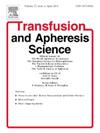骨髓增生异常综合征患者的血液使用和同种异体免疫:一项医院输血经验的研究。
IF 1.4
4区 医学
Q4 HEMATOLOGY
引用次数: 0
摘要
背景:骨髓增生异常综合征(MDS)患者以慢性贫血为特征,大多数患者需要输血,容易发生输血依赖(TD)和诱导红细胞(RBC)异体免疫。关于中国MDS患者输血状况的信息很少。材料与方法:收集2004 ~ 2023年MDS输血患者的临床病史和输血信息,收集电子病历和实验室记录。将TD患者分为增原细胞组(IB)和非IB组。采用Mann-Whitney检验和卡方检验对不同组的血液成分输血进行评价和比较。结果:共有893名MDS患者接受了中位数为13(范围,0 - 436)个红细胞单位和10(范围,0 - 216)个血小板(PLT)单位。71例(8%)患者形成106种RBC特异性抗体,其中Rh系统抗体最多(82/106 = 77%)。有12例(17%)患者有14种抗体消失(13%),而7例患者有原有抗体重新出现。同种异体免疫在女性、老年患者和红细胞输注量较大的患者中更为常见。222例TD患者中,IB组红细胞输注率和同种异体免疫率低于非IB组,而PLT组则相反。结论:预防性Rh系统兼容输血可降低MDS患者特别是TD和非ib患者红细胞异体免疫的风险,并可防止抗体再诱导消失。据我们所知,这是我们首次发现红细胞抗体诱导和消失可能与MDS患者不同的疾病分期和分类有关。本文章由计算机程序翻译,如有差异,请以英文原文为准。
Blood use and alloimmunization in myelodysplastic syndrome patients: A study of a hospital transfusion experience
Background
Patients with myelodysplastic syndrome (MDS) are characterized by chronic anemia and most of them require transfusion making them prone to developing transfusion dependence (TD) and inducing red blood cell (RBC) alloimmunization. Little information is available regarding the status of transfusions of MDS patients in China.
Materials and methods
Clinical history and transfusion information of MDS transfusion patients from 2004 to 2023 were collected from electronic medical and laboratory records. TD patients were divided into increased blasts (IB) and non-IB group. Blood component transfusion was evaluated and compared in different groups using Mann-Whitney and chi-square tests.
Results
A total of 893 MDS patients received a median of 13 (range, 0 - 436) RBC units and 10 (range, 0 - 216) platelets (PLT) units. Seventy-one (8 %) patients formed 106 RBC specific antibodies of which Rh system was the most (82/106 = 77 %). Twelve patients (17 %) had 14 antibodies (13 %) evanescence whereas 7 patients had former antibodies reemerge. Alloimmunization was more common in female, older patients and patients with larger RBC transfusions. Among 222 TD patients, RBC transfusion and alloimmunization rate in IB group were lower than those in non-IB group whilst PLT was the opposite.
Conclusions
Prophylactic Rh system compatible transfusion can reduce the risk of RBC alloimmunization in MDS patients’ especially in TD and non-IB patients and can prevent reinduction of antibody evanescence. To our knowledge this is the first study we reveal RBC antibody induction and evanescence which may related to different disease stages and classifications of MDS patients
求助全文
通过发布文献求助,成功后即可免费获取论文全文。
去求助
来源期刊
CiteScore
3.60
自引率
5.30%
发文量
181
审稿时长
42 days
期刊介绍:
Transfusion and Apheresis Science brings comprehensive and up-to-date information to physicians and health care professionals involved in the rapidly changing fields of transfusion medicine, hemostasis and apheresis. The journal presents original articles relating to scientific and clinical studies in the areas of immunohematology, transfusion practice, bleeding and thrombotic disorders and both therapeutic and donor apheresis including hematopoietic stem cells. Topics covered include the collection and processing of blood, compatibility testing and guidelines for the use of blood products, as well as screening for and transmission of blood-borne diseases. All areas of apheresis - therapeutic and collection - are also addressed. We would like to specifically encourage allied health professionals in this area to submit manuscripts that relate to improved patient and donor care, technical aspects and educational issues.
Transfusion and Apheresis Science features a "Theme" section which includes, in each issue, a group of papers designed to review a specific topic of current importance in transfusion and hemostasis for the discussion of topical issues specific to apheresis and focuses on the operators'' viewpoint. Another section is "What''s Happening" which provides informal reporting of activities in the field. In addition, brief case reports and Letters to the Editor, as well as reviews of meetings and events of general interest, and a listing of recent patents make the journal a complete source of information for practitioners of transfusion, hemostasis and apheresis science. Immediate dissemination of important information is ensured by the commitment of Transfusion and Apheresis Science to rapid publication of both symposia and submitted papers.

 求助内容:
求助内容: 应助结果提醒方式:
应助结果提醒方式:


